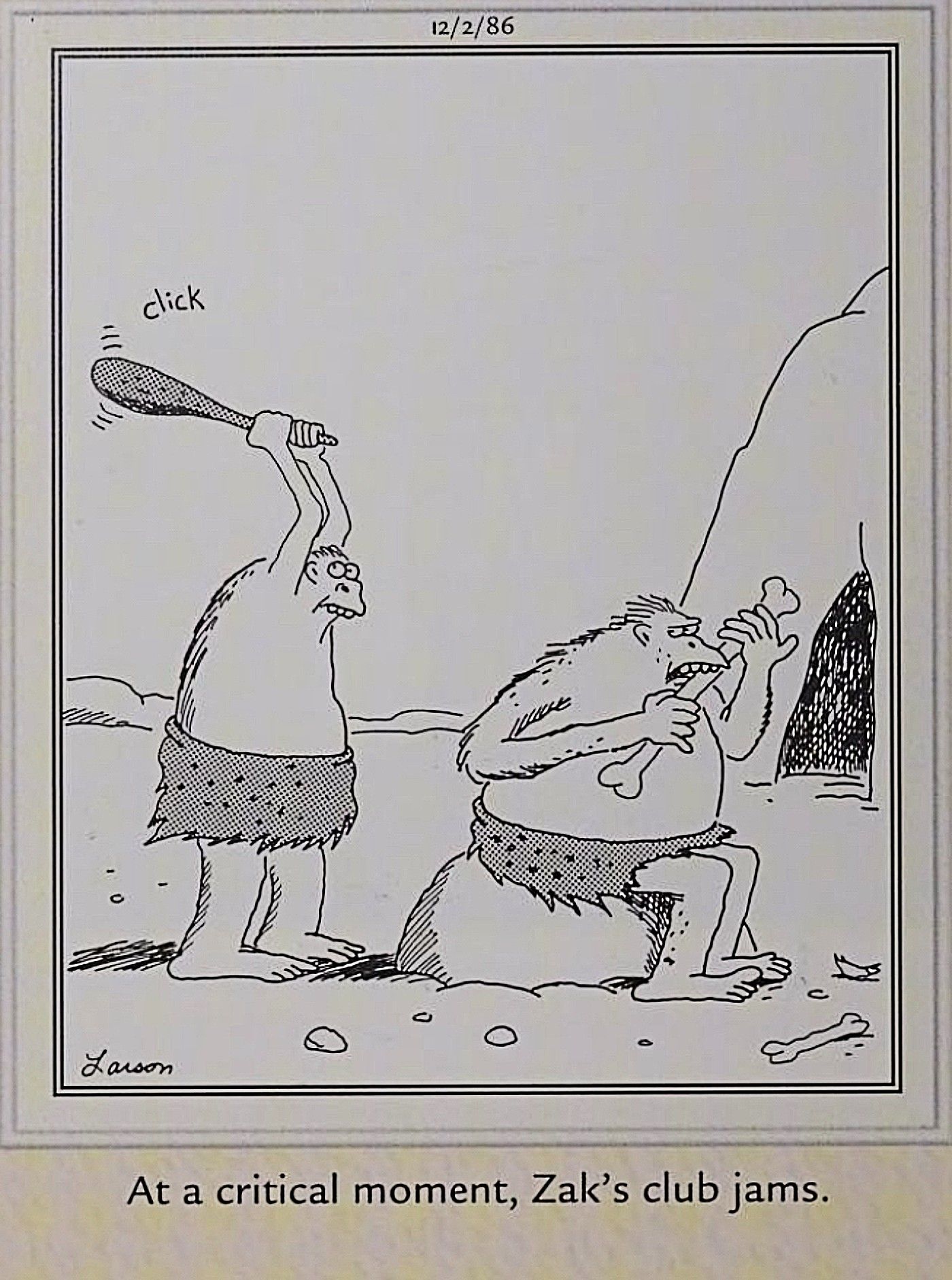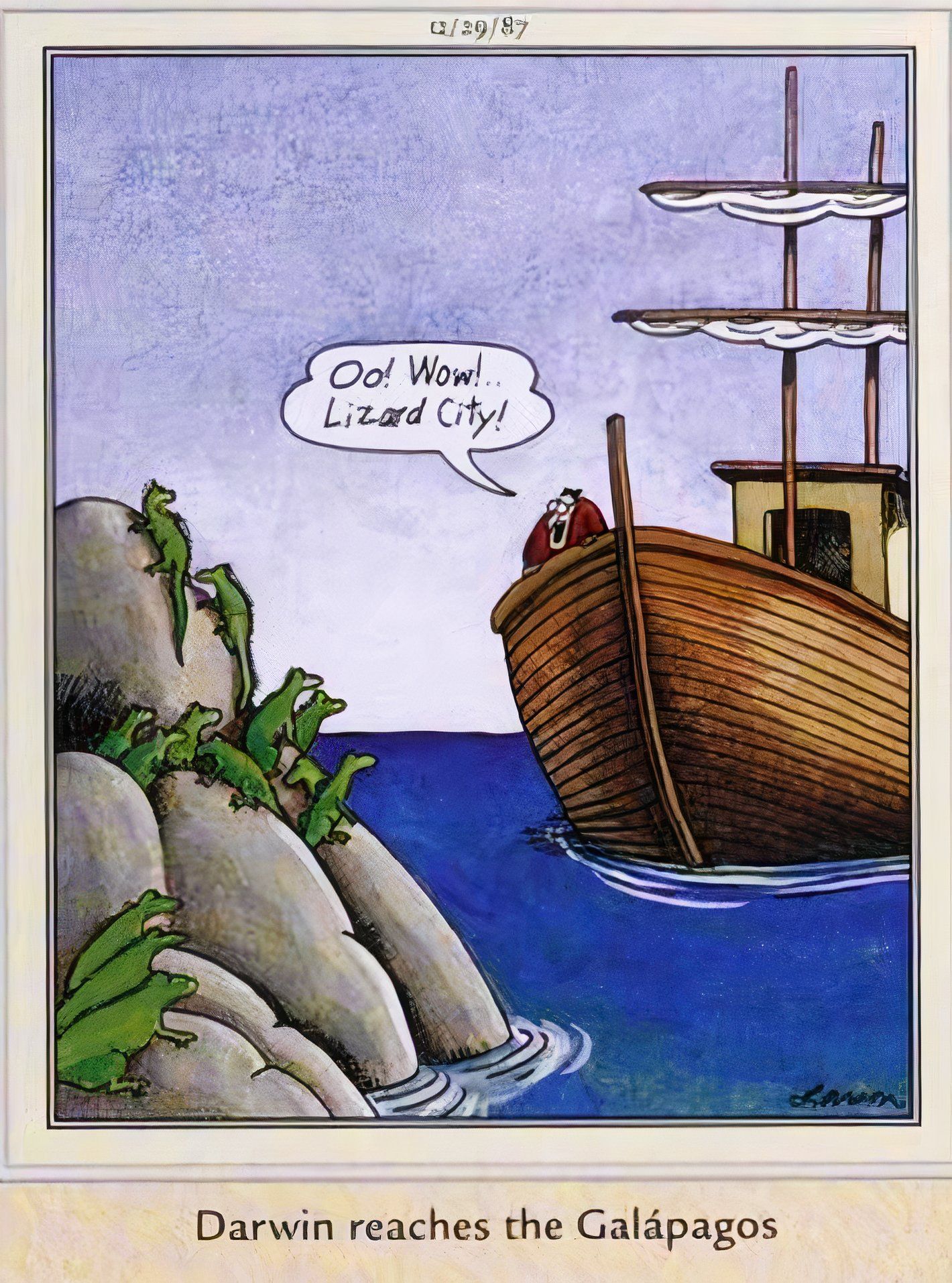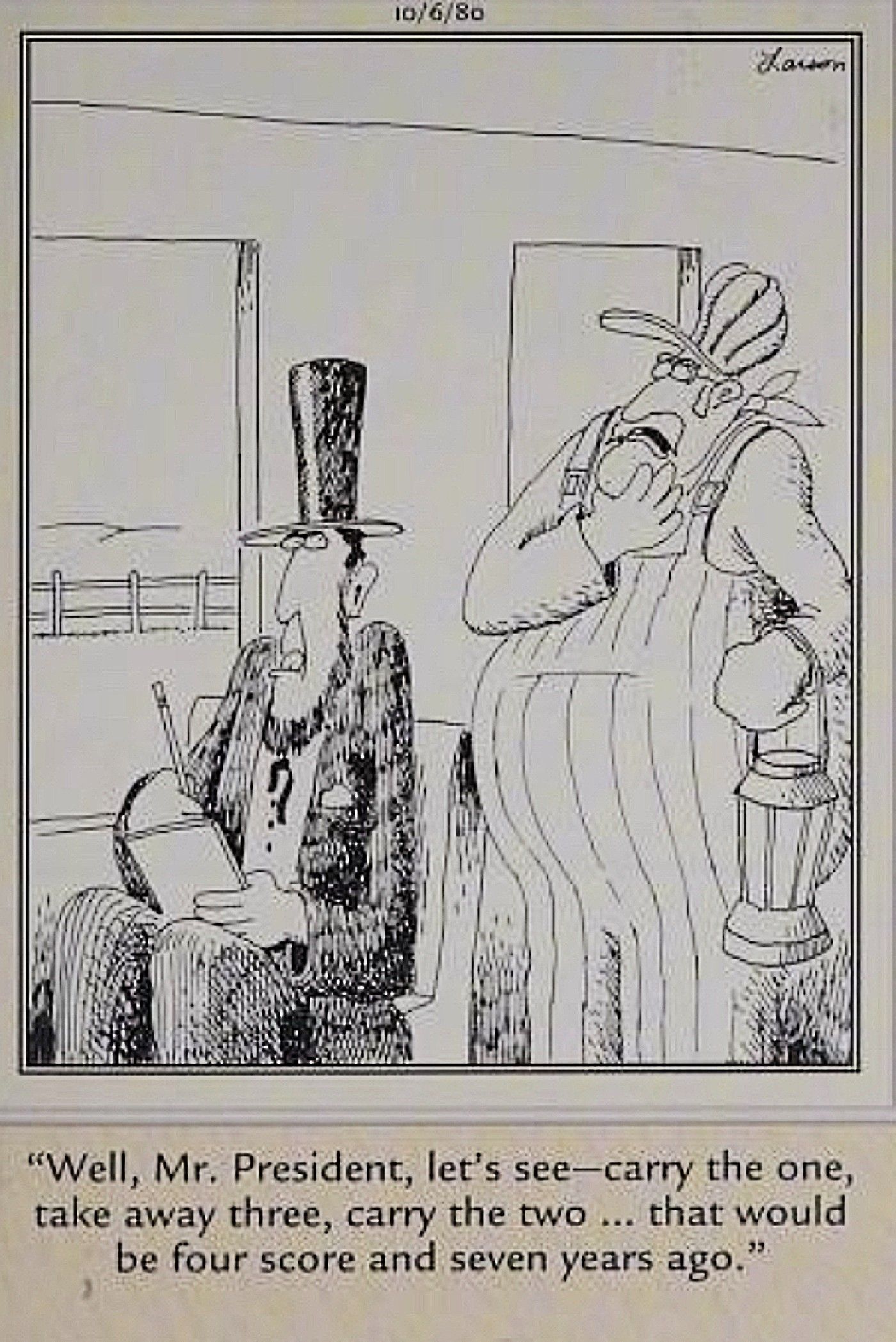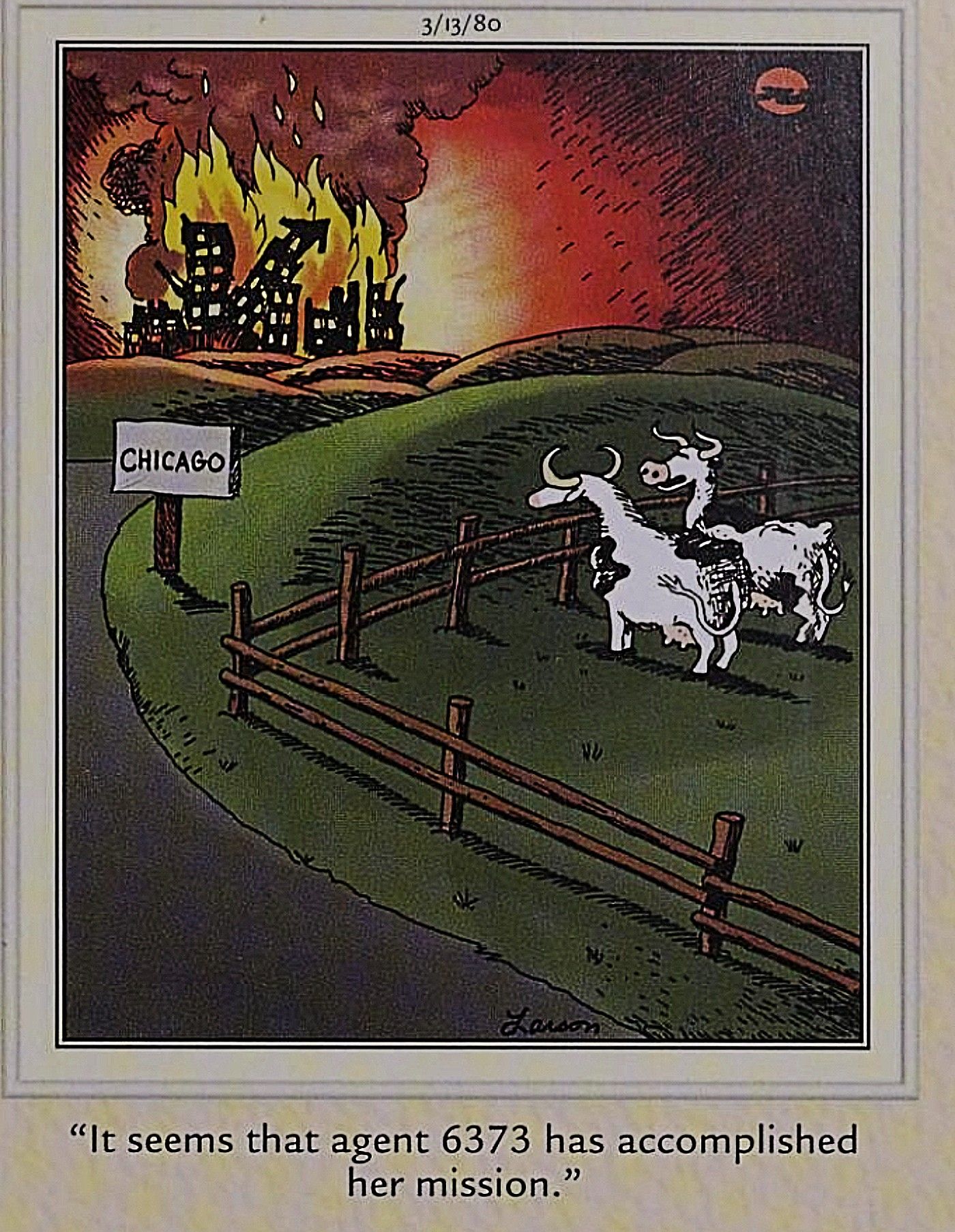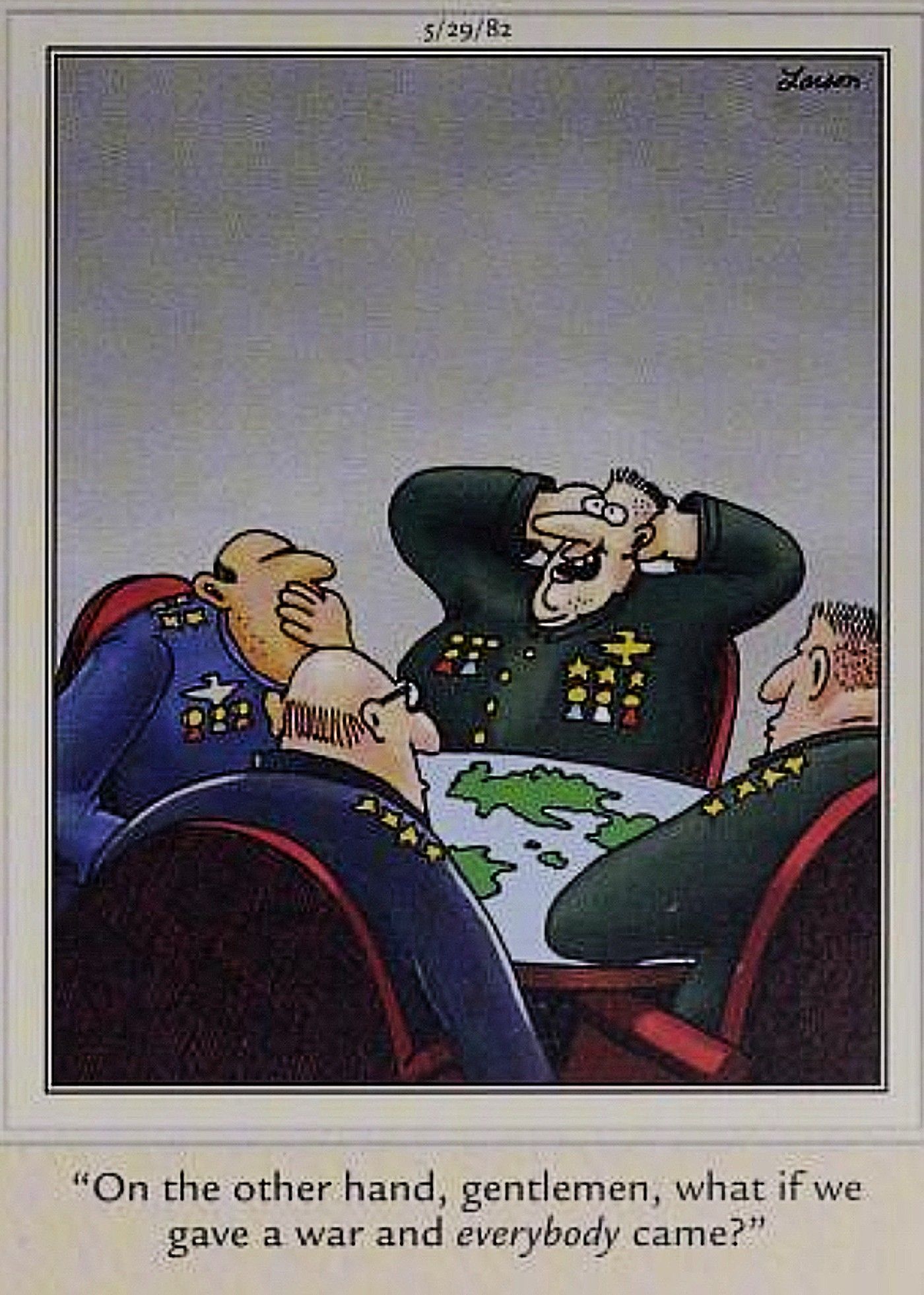Summary
- Gary Larson’s iconic
Far Side
comics took historical subjects and turned them and used them in his patented comedic style, invigorating them with silly humor and modern twists. - From cave-people to George Washington, Larson humorously depicted historical figures in unconventional and hilarious ways.
-
The Far Side
provided particular insight into Larson’s worldview through historically-influenced panels, as opposed to some of the artist’s more absurd, obscure panels, making them essential to study for any fan.
The Far Side, Gary Larson’s iconic syndicated comic, rarely used recurring characters, but it did frequently revisit the same subjects for material again and again. One of these was history, as Larson often took familiar moments from the past and put them in the absurd, unique context his work became synonymous with, and beloved for.
The Far Side’s view of history encompasses the entirety of civilization, from the origins of the species to the potential end of the world. Invariably, Gary Larson sought to turn his readers’ familiarity with these moments on their ear, making use of familiar historical settings and figures in an unfamiliar way – just as he did with everything from inanimate objects to household pets.
Unlike many of his more absurd Far Side entries, Larson’s historically-influenced panels offer a more nuanced insight into his worldview, making them essential to study for any fan of the artist’s work.
2:17
Related
15 Funniest Far Side Comics That Make Fun of Real People
Gary Larson’s The Far Side is known for its surreal sense of humor and often morbid subject matter, but there were times it took on celebrities.
The entries on this list are arranged chronologically, ranging from the deepest reaches of pre-history up through the 1980s, when Larson was at the peak of his
Far Side
run. All the examples below are drawn from the years 1980-87.
15 Some Problems Go All The Way Back To Pre-History
First Published: December 2, 1986
Gary Larson frequently depicted cave-people in his work, often infusing their activities with a modern spin.
Of all the epochs of human history, Gary Larson devoted the most Far Side panels to the species’ most primitive ancestors. Larson frequently depicted cave-people in his work, often infusing their activities with a modern spin, as is the case in this panel where one caveman attempts to sneak behind another and kill him, only for his club to “jam” the way a modern firearm might.
Considering the actual activities of humanity’s ancient progenitors would be totally alien to modern readers, depicting contemporary problems in an ancient setting was a perfect way for Larson to get a laugh.
14 The Vikings Rebrand Thanks To An Iconic Innovation
First Published: October 2, 1982
Above all else, the one thing about the Middle Ages’ infamous Viking raiders almost any reader can recognize is their iconic horned helmet design. The look endures in the popular consciousness over a thousand years after the height of their activities, as a testament to how imposing it would have been for the unfortunate villages and port cities they plundered.
Gary Larson delightfully depicts the moment that innovator “Bjorn Jorgensen” changes history forever, by introducing the horned helmet to his Viking cohorts, who up to this point in The Far Side’s version of Viking history are uniformly wearing hats that look somewhat goofy, rather than scary.
13 The Far Side’s Unique Addition To The Lore Of The First Thanksgiving
First Published: February 15, 1987
Whatever the historical fact of the event might be, the first Thanksgiving is deeply engrained in American cultural lore – something that Gary Larson plays with in This Far Side cartoon with a goofy anachronism. Written in the tone of a history textbook, the caption deadpan notes: “Thomas Sullivan, a blacksmith who attended the original Thanksgiving dinner, is generally credited with being the first person to stick olives on all his fingers.”
Visually, Larson’s punchline here rests on the fact that the panel is presented as a very straightforward rendition of the first Thanksgiving – with the subtly amusing exception of Sullivan’s olive-finger innovation.
12 The Race To “Discover” America Was Even More Competitive Than Readers Think
First Published: May 17, 1987
With any given panel, Gary Larson’s artistic style ranged from straightforward black-and-white pencil sketches to detailed, full-color illustrations – with this being an example of the latter, as here, The Far Side depicts something of an immature rivalry among the ships Christopher Columbus’ fleet.
In this panel, the crew of the Nina hanga sign that reads “Eat our wake, Pintaheads!“ directed at the crew of the nearby Pinta. Once again, Gary Larson effectively used The Far Side as an opportunity to irreverently – and amusingly – undermine the most common myths about the early exploration and colonization efforts of Europeans in North America.
11 Washington Won The War By Any Means Necessary
First Published: October 11, 1980
[Gary Larson] portrays [Washington] as leading his men to victory through any means necessary – yet, at the same time, the gravitas of the moment can’t help but be undercut by the added silliness.
George Washington’s 1776 crossing of the Delaware River is usually depicted as a triumphant moment, as it involed a small band of revolutionaries surmounting the elements in order to win a crucial victory in the War for Independence. Recreating a famous 1851 painting of the crossing, Gary Larson reimagines the iconic row boat as a motorboat, courtesy of “Sid’s Rentals.”
Washington appears no less dignified in Larson’s version, and if anything, it portrays him as leading his men to victory through any means necessary – yet, at the same time, the gravitas of the moment can’t help but be undercut by the added silliness.
10 The Far Side Offers An Entirely Different Context For A Classic High Seas Tale
First Published: May 7, 1987
The punchline of this Far Side comic relies on Gary Larson’s penchant for silly wordplay – as the famous “mutiny on the Bounty,” a historical event that took place in 1789, is transformed into something entirely different, instead depicting “mutants on the Bounty.”
The illustration features a group of Larson’s intentionally-poorly drawn human characters, who appear to be having a good enough time at the helm of the archaic British vessel, suggesting that these mutants fared much better than the crew of the historical Bounty, both the mutineers and loyalists aboard alike. That said, it is the pun in the caption, however, that will truly tickle Far Side fans.
9 Gary Larson’s Approach To History Evolved Over The Far Side’s Run
First Published: December 19, 1987
This panel hilariously depicts the moment “Darwin reaches the Galapagos,” with the history-making moment for the father of evolution being summed up by Gary Larson with the words: “Oo, wow! Lizard city!“
In many ways, the humor of The Far Side was remarkably well-developed by the time it entered publication in 1980, but there are ways in which its growth over the course of the comic’s run in publication is evident. Larson’s jokes about real-life history are a prime example; as time went on, The Far Side found increasingly niche ways to subvert readers’ expectations about the historical record – even if the method was as simple as putting modern-sounding words in Darwin’s mouth.
8 These Far Side Alamo Shirts Belong In The Museum Of “Spoke Too Soon”
First Published: March 21, 1987
In one of the funniest Far Side cartoons about real history, a man selling “I kicked Santa Anna’s butt at the Alamo” shirts at the infamous battle steadily reduces his prices as the fight becomes increasingly bleak for the Texan independence fighters.
Like Super Bowl victory merchandise printed for the losing team, the t-shirt vendor’s design is quickly made into a novelty as the fort’s defenders fall one-by-one to the Mexican President General’s forces. In other words, while they might make for some quality Far Side merch, these Alamo shirts are otherwise to be relegated to a museum for lost causes and bad predictions.
7 Abraham Lincoln Gets Some Help With His Math
First Published: October 6, 1980
Similar to his portrayal of George Washington, here Gary Larson depicts a president in need of some assistance from the average citizen in order to achieve one of the defining moments of his tenure in office. The famous anecdote about Abraham Lincoln’s 1863 Gettysburg Address involves him composing his speech on the train as he approached the site of the battlefield.
Larson shows Lincoln needing help from the train conductor with one crucial part of his speech – the “four score and seven years” math at the beginning, as he figures out how many years it has been since the country’s founding.
6 The Great Chicago Fire Was An Act Of Sabotage
First Published: March 13, 1980
Larson confirms [the Great Fire] to have not been an accident, as one cow remarks: ”
It seems that agent 6373 has accomplished her mission,
” revealing a deliberate effort to destablize human society on the part of cows.
As much as Gary Larson loved to write about history, he also loved to write about cows. This panel brings those two interests together for one of the funniest Far Side jokes, as two cows watch Chicago burn during the Great Fire of 1871. Famously, the conflagration started when a cow kicked over a lantern onto a pile of hay.
Larson confirms this to have not been an accident, as one cow remarks: “It seems that agent 6373 has accomplished her mission,“ revealing a deliberate effort to destablize human society on the part of cows.
2:46

Related
15 Funniest Far Side Comics Starring Its ‘Nerdy Kid’ Recurring Character (Including 2 of Gary Larson’s All Time Best)
Gary Larson’s Far Side didn’t officially use recurring characters, but his repeated use of ‘the Nerdy Kid’ led to some of his best comics.
5 It’s Not The “Gunfight At The Okeedokee Coral,” Fellas
First Published: May 19, 1982
Time and again, The Far Side often found humor in its characters making obvious mistakes. Over the comic’s run, creator Gary Larson frequently displayed that he was enamored with cowboy jokes, frequently visiting the American Old West to tell some of his goofiest jokes.
Once again, these two tendencies came together to produce a truly “laugh out loud” panel, as a group of gunslingers on their way to 1881’s famed “Gunfight at the O.K. Corral” misread the directions and wind up at the “Okeedokee Corral,” making them late for their date with history.
4 Nobody Ever Said Trench Warfare Was All Fun & Games
First Published: August 18, 1980
World War I infamously featured the clash of classical 18th and 19th-century European war tactics with the devastating emergence of modern 20th-century weaponry. This led to brutal years of what was known as trench warfare.
Gary Larson impressively manages to find humor in the darkest of places with this strip, as an exasperated officer yells at a subordinate to, “just pull the pin, throw the grenade, and refrain from yelling ‘heads’!” All the while, the opposing army peek expectantly over the lip of the trench in the distance, in one of Larson’s most understated, but amusing, compositions.
3 Amelia Earhart’s Disappearance, As Inconvenient As It Was Mysterious
First Published: August 19, 1980
Amelia Earhart famously disappeared while trying to fly around the world in 1937. Gary Larson imagines the crowd waiting for her to return home, with the humor coming from the fact that he skips over any worry or display of concern, as one of the members of the expectant gathered crowd notes: “Well, I’m just starting to worry about that roast in the oven, that’s all.”
Unfortunately, Earhart never came back from her flight, meaning that the roast was probably burnt to a crisp by the time the speaker got home.
A 1987
Far Side
cartoon
followed up on this panel, revealing the grim fate of Amelia Earhart, as her bones were discovered on a desert island by a pair of shipwreck survivors.
2 JFK’s Inaugural Address Inspires An Anthill
First Published: May 7, 1980
[JFK’s] reputation was solidified by his 1961 inaugural address, which Larson lampoons here by having an ant leader repeat the words to a thriving community of ants:
John J. Kennedy is one of the most well-known presidents of the 20th century. In large part, this stems from the tragic end to his time in office – but even before his assassination in 1963, Kennedy was known as a charismatic, young politician, the first U.S. President of the television age.
This reputation was solidified by his 1961 inaugural address, which Gary Larson lampoons in this Far Side panel by having an ant leader repeat the words to a thriving community of ants: “And remember…ask not what your anthill can do for you, but what you can do for your anthill.“
1 Gary Larson Satirizes The Hippie Movement
First Published: May 29, 1982
Published in 1982, a decade before the fall of the Soviet Union, Larson’s comic represents the still pressing anxieties of the Cold War conflict, as well as a bitterness at the way anti-war activism failed to impact those who really wielded American military power, even at the height of the movement.
Gary Larson was born in 1950, making him definitively a child of the Cold War between the United States and the Soviet Union. Larson came of age at the time of the hippie movement, and began producing Far Side comics in 1975, at the height of the balance of terror, with the looming threat of nuclear war still constant. Here, Larson critiques the slogan popularized by peace protesters in the 1960s, “what if they gave a war and nobody came?” by showing a group of military leaders around a map, jovially asking the opposite question.
“On the other hand, gentlemen, what if we gave a war and everybody came?” Published in 1982, a decade before the fall of the Soviet Union, Larson’s comic represents the still pressing anxieties of the Cold War conflict, as well as a bitterness at the way anti-war activism failed to impact those who really wielded American military power, even at the height of the movement. As a result, this panel was one of Gary Larson’s most overtly political comics, proving his historical perspective to be as insightful as his best Far Side jokes.

The Far Side
The Far Side is a humorous comic series developed by Gary Larson. The series has been in production since 1979 and features a wide array of comic collections, calendars, art, and other miscellaneous items.



